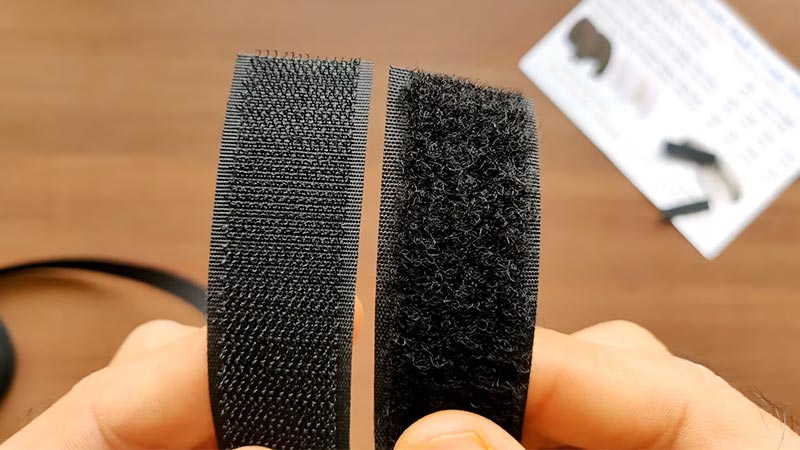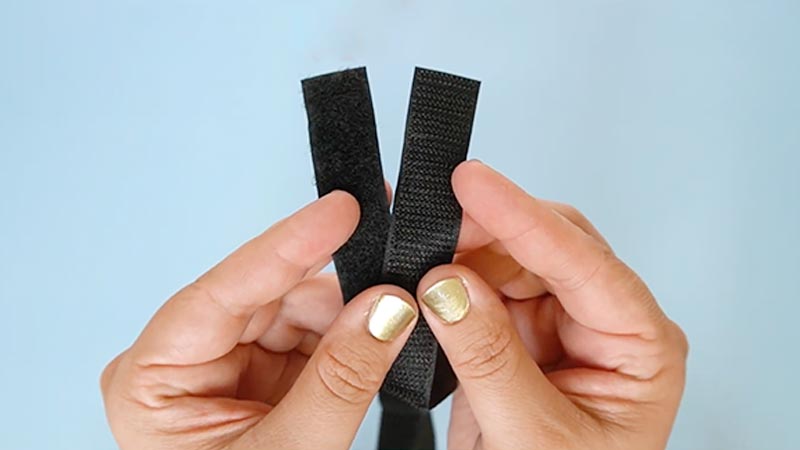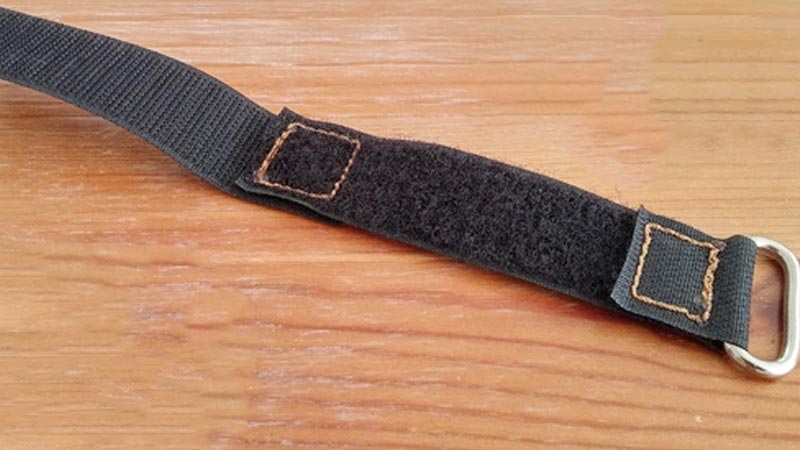Choosing the right adhesive for attaching sew-in Velcro is a critical decision in many fabric projects. Sew-in Velcro, with its hook and loop fastening system, offers a convenient and adjustable solution for closures and attachments.
However, to ensure a secure and durable bond, selecting the appropriate adhesive is paramount. In this guide, we explore the world of adhesives that work effectively with sew-in Velcro, providing insight into the various types, strengths, and applications of these adhesives.
From fabric glue to adhesive tapes, we’ll delve into the options, considerations, and best practices for successful adhesion, ensuring that your fabric projects benefit from a reliable and lasting connection between Velcro and fabric.

What Adhesive Works On Sew-in Velcro?
When it comes to adhering sew-in Velcro to fabric, various adhesives can be used effectively. The choice of adhesive often depends on the specific requirements of your project and your personal preferences.
Here are some common adhesives that work well with sew-in Velcro:
Fabric Glue
Fabric glue is a versatile and reliable choice for attaching sew-in Velcro to the fabric. It is designed to bond fabric and is available in different formulations to suit various fabric types.
Be sure to select a fabric glue that is appropriate for your specific project and follow the manufacturer’s instructions for application and drying times. Fabric glue provides a strong and durable bond.
Permanent Fabric Tape
Some manufacturers offer permanent fabric tapes that have adhesive on both sides. These tapes are convenient and easy to use, making them an excellent choice for attaching sew-in Velcro without sewing. Simply cut the tape to the desired length, apply it to the fabric, and press the Velcro in place.
Liquid Stitch Adhesive
Liquid Stitch is a popular fabric adhesive that provides a strong and lasting bond. It’s known for its versatility and clear drying properties, which ensure no visible residue on your project. Liquid Stitch is suitable for attaching sew-in Velcro securely.
Heat-Activated Adhesives
Heat-activated adhesives, such as heat-n-bond, can be used to bond sew-in Velcro to fabric. These adhesives require heat, often from an iron, to activate and create a strong bond. They are particularly useful for projects that require a permanent and solid connection.
Be cautious with heat-activated adhesives, as excessive heat can damage certain fabric types. Always follow the product instructions and perform a test on a fabric scrap before applying it to your project.
Spray Adhesives
Fabric spray adhesives are a quick and convenient option for attaching sew-in Velcro. They offer a temporary bond, allowing you to reposition the Velcro before sewing it in place. Spray adhesives are easy to apply and dry quickly.
How to Choose the Right Adhesive for Sew-in Velcro: A Comprehensive Guide

Sew-in Velcro, a versatile fastening solution used in various fabric projects, relies on the adhesive that attaches it to the fabric for strength and durability. The choice of adhesive is crucial, as it can significantly impact the success of your project.
Here’s a comprehensive guide on how to choose the right adhesive for sew-in Velcro:
Understand Your Project’s Requirements
Begin by thoroughly understanding the specific needs of your project. Different projects require different adhesive properties. Are you attaching Velcro to clothing, bags, home decor, or industrial items? Each application may necessitate distinct adhesive characteristics.
Assess Environmental Factors
Consider the environment in which your project will be used. Think about factors like moisture, heat, and exposure to chemicals. Some adhesives are more resilient under specific conditions, so select one that can withstand the environmental challenges your project may encounter.
Evaluate the Fabric Type
The fabric you’re working with plays a significant role in adhesive selection. Examine the fabric’s characteristics, such as thickness, texture, and flexibility. The chosen adhesive should be compatible with the specific fabric type to ensure a strong bond.
Determine the Level of Permanence
Decide whether you need a permanent, temporary, or repositionable bond. The level of permanence required depends on the intended use of the Velcro.
For instance, a permanent bond is suitable for clothing closures, while a temporary bond may be preferable for items that need occasional adjustments.
Explore Different Adhesive Options
Research the various adhesive options available. Some of the common choices include fabric glue, permanent fabric tape, liquid stitch adhesive, heat-activated adhesives, and fabric spray adhesives. Each type has its unique advantages and is suitable for different applications.
Read Product Labels and Descriptions
Pay close attention to the labels and product descriptions of adhesives. Manufacturers often provide information about the types of materials the adhesive is suitable for and its recommended uses. This information can help you narrow down your options.
Consult User Reviews
Online reviews and user experiences can offer valuable insights into the performance of specific adhesives. Look for feedback from individuals who have used the adhesive for projects similar to yours. These reviews can help you make an informed decision.
Test on a Fabric Scrap
Before applying the adhesive to your actual project, perform a test on a small fabric scrap. This step is crucial to ensure compatibility and assess the adhesive’s performance. Testing also helps you become familiar with the adhesive’s behavior.
Ensure Aesthetic Compatibility
Some adhesives may leave visible residues or affect the appearance of the fabric. After performing the adhesive test, check for any aesthetic changes to ensure your project maintains a pleasing look.
Consider Safety Standards
If your project requires adherence to safety standards, ensure that the chosen adhesive complies with these standards. This is particularly important in specialized applications such as medical or industrial projects.
Budget Constraints
If you have budget constraints, factor in the cost of the adhesive. Adhesives are available in various price ranges, so choose one that aligns with your budget without compromising quality.
Seek Professional Advice
If you’re uncertain about the best adhesive for your project, don’t hesitate to seek advice from a professional or consult with experts at a fabric or craft store. Their experience and knowledge can be invaluable in making the right choice.
Follow the Manufacturer’s Instructions
Regardless of the adhesive you choose, always follow the manufacturer’s instructions for application and drying times. Adhering to these guidelines ensures the best results and a strong bond.
How Can You Effectively Use Adhesive on Sew-in Velcro?

Sew-in Velcro is a versatile and widely used fastening solution in fabric projects. While sewing Velcro in place is a common practice, using adhesive to attach sew-in Velcro can be an effective and convenient alternative.
This method doesn’t require sewing skills and can save time. However, it’s crucial to apply the adhesive correctly to ensure a strong and durable bond.
Here’s a step-by-step guide on how to effectively use adhesive on sew-in Velcro:
Materials You’ll Need
- Sew-in Velcro strips
- Fabric adhesive suitable for your project (e.g., fabric glue, adhesive tape)
- Scissors
- A fabric scrap for testing (optional)
- Cleaning supplies (if needed)
- A sewing machine and thread (for additional reinforcement, if desired)
Step-by-Step Instructions:
Clean and Prepare the Fabric
Start by ensuring the fabric is clean and free from any dirt, dust, or residues. If necessary, wash and dry the fabric before proceeding. A clean surface promotes better adhesion.
Cut the Sew-In Velcro Strips
Measure and cut the sew-in Velcro strips to the desired length. Ensure you have both the hook (rough) and loop (soft) sides.
Test the Adhesive (Optional)
Before applying adhesive directly to your project, it’s a good practice to perform a test on a fabric scrap. This test helps determine the compatibility of the adhesive with your fabric and assess the strength of the bond it creates.
Apply the Adhesive
Follow the manufacturer’s instructions for the selected fabric adhesive carefully. Apply the adhesive to the area of the fabric where you intend to attach the sew-in Velcro. Adhesives may come in different forms, such as liquid, spray, or adhesive tape, so use the recommended method.
Position the Velcro
Place the cut Velcro strips onto the adhesive-coated area of the fabric. Ensure the strips are correctly aligned, whether you’re using the hook or loop side of the Velcro.
Press and Hold
Gently but firmly press the Velcro onto the adhesive-coated fabric, holding it in place for a few seconds. This helps create a strong initial bond between the Velcro and the fabric.
Allow for Drying or Activation
Depending on the type of adhesive used, you may need to allow it to dry naturally or activate it by applying heat. Follow the manufacturer’s instructions regarding the appropriate drying or activation time.
Test Bond Strength (Optional)
After the adhesive has dried or activated, you can test the bond strength by pulling, stretching, or applying force to the Velcro. Ensure that it adheres securely and can withstand the expected stress.
Sew the Velcro (Optional)
For added durability, especially in projects where the Velcro will undergo significant wear and tear, it’s advisable to sew the sew-in Velcro onto the fabric after the adhesive has dried. Sewing provides extra reinforcement and ensures a longer-lasting bond.
Assess the Aesthetic Impact
Inspect the fabric and the Velcro for any visible residue or changes in appearance. Ensure the adhesive doesn’t negatively affect the aesthetics of your project.
Clean Up (if necessary)
If any adhesive has seeped out from the Velcro edges, carefully clean it up using a suitable cleaning agent. Always follow the adhesive manufacturer’s guidelines for adhesive removal.
FAQs
What are the best adhesives for sew-in Velcro attachments?
The best adhesives for sew-in Velcro attachments include fabric glue, permanent fabric tape, and heat-activated adhesives, chosen based on the fabric and project requirements.
What is the importance of testing adhesives before using them on sew-in Velcro?
Testing adhesives is crucial to assess compatibility with fabric, bond strength, and any potential aesthetic impact, ensuring project success and durability.
Are there adhesive options for different fabric types when working with sew-in Velcro?
Yes, adhesive options for sew-in Velcro vary based on fabric types. Consider compatibility with fabric thickness, texture, and stretch when choosing the adhesive.
How do I remove adhesives from sew-in Velcro if I make a mistake?
To remove adhesive from sew-in Velcro, use an adhesive remover, apply heat or solvents as directed by the manufacturer, or carefully scrape it off without damaging the fabric.
Are there any long-term aesthetic concerns when choosing adhesives for sew-in Velcro?
Yes, long-term aesthetic concerns include residue visibility and potential fabric damage. Choosing adhesives that dry clear and don’t affect the fabric’s appearance is essential.
To Recap
In the world of fabric projects, choosing the right adhesive for sew-in Velcro proves to be a pivotal decision. This guide has provided a comprehensive overview of the adhesives that work effectively with sew-in Velcro.
By exploring various adhesive types, strengths, and their compatibility with different fabrics, you can make informed choices for your projects.
The significance of selecting the correct adhesive cannot be overstated, as it directly impacts the longevity, strength, and overall success of your Velcro attachments.
The guidance on project-specific considerations, adhesive testing, and the aesthetic aspects of adhesive selection ensures that your fabric creations not only function impeccably but also look polished and professional.
Your sewing and fabric projects can now benefit from a strong and dependable Velcro bond, thanks to the right adhesive choice.
Leave a Reply